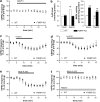Abnormal mGlu 5 receptor/endocannabinoid coupling in mice lacking FMRP and BC1 RNA
- PMID: 20393458
- PMCID: PMC3055456
- DOI: 10.1038/npp.2010.19
Abnormal mGlu 5 receptor/endocannabinoid coupling in mice lacking FMRP and BC1 RNA
Abstract
Transcriptional silencing of the gene encoding the fragile X mental retardation protein (FMRP) causes fragile X syndrome (FXS). FMRP acts as a translational repressor at central synapses, and molecular and synaptic plasticity studies have shown that the absence of this protein alters metabotropic glutamate 5 receptors (mGlu5Rs)-mediated signaling. In the striatum of mice lacking FMRP, we found enhanced activity of diacylglycerol lipase (DAGL), the enzyme limiting 2-arachidonoylglicerol (2-AG) synthesis, associated with altered sensitivity of GABA synapses to the mobilization of this endocannabinoid by mGlu5R stimulation with DHPG. Mice lacking another repressor of synaptic protein synthesis, BC1 RNA, also showed potentiated mGlu5R-driven 2-AG responses, indicating that both FMRP and BC1 RNA act as physiological constraints of mGlu5R/endocannabinoid coupling at central synapses. The effects of FMRP ablation on DAGL activity and on DHPG-mediated inhibition of GABA synapses were enhanced by simultaneous genetic inactivation of FMRP and BC1 RNA. In double FMRP and BC1 RNA lacking mice, striatal levels of 2-AG were also enhanced compared with control animals and to single mutants. Our data indicate for the first time that mGlu5R-driven endocannabinoid signaling in the striatum is under the control of both FMRP and BC1 RNA. The abnormal mGlu5R/2-AG coupling found in FMRP-KO mice emphasizes the involvement of mGlu5Rs in the synaptic defects of FXS, and identifies the modulation of the endocannabinoid system as a novel target for the treatment of this severe neuropsychiatric disorder.
Figures





Similar articles
-
Activation of type 5 metabotropic glutamate receptors and diacylglycerol lipase-α initiates 2-arachidonoylglycerol formation and endocannabinoid-mediated analgesia.J Neurosci. 2012 Jul 11;32(28):9457-68. doi: 10.1523/JNEUROSCI.0013-12.2012. J Neurosci. 2012. PMID: 22787031 Free PMC article.
-
The endocannabinoid 2-arachidonoylglycerol produced by diacylglycerol lipase alpha mediates retrograde suppression of synaptic transmission.Neuron. 2010 Feb 11;65(3):320-7. doi: 10.1016/j.neuron.2010.01.021. Neuron. 2010. PMID: 20159446
-
Endocannabinoid- and mGluR5-dependent short-term synaptic depression in an isolated neuron/bouton preparation from the hippocampal CA1 region.J Neurophysiol. 2008 Aug;100(2):1041-52. doi: 10.1152/jn.90226.2008. Epub 2008 May 21. J Neurophysiol. 2008. PMID: 18497350 Free PMC article.
-
The diacylglycerol lipases: structure, regulation and roles in and beyond endocannabinoid signalling.Philos Trans R Soc Lond B Biol Sci. 2012 Dec 5;367(1607):3264-75. doi: 10.1098/rstb.2011.0387. Philos Trans R Soc Lond B Biol Sci. 2012. PMID: 23108545 Free PMC article. Review.
-
Adaptations of striatal endocannabinoid system during stress.Mol Neurobiol. 2009 Jun;39(3):178-84. doi: 10.1007/s12035-009-8061-4. Epub 2009 Mar 7. Mol Neurobiol. 2009. PMID: 19267225 Review.
Cited by
-
Inhibition of fatty acid amide hydrolase prevents pathology in neurovisceral acid sphingomyelinase deficiency by rescuing defective endocannabinoid signaling.EMBO Mol Med. 2020 Nov 6;12(11):e11776. doi: 10.15252/emmm.201911776. Epub 2020 Oct 5. EMBO Mol Med. 2020. PMID: 33016621 Free PMC article.
-
Current state of evidence of cannabis utilization for treatment of autism spectrum disorders.BMC Psychiatry. 2019 Oct 29;19(1):328. doi: 10.1186/s12888-019-2259-4. BMC Psychiatry. 2019. PMID: 31664964 Free PMC article. Review.
-
Getting high on the endocannabinoid system.Cerebrum. 2013 Nov 1;2013:14. eCollection 2013 Nov. Cerebrum. 2013. PMID: 24765232 Free PMC article.
-
Noncoding RNA Regulation of Dopamine Signaling in Diseases of the Central Nervous System.Front Mol Biosci. 2016 Oct 25;3:69. doi: 10.3389/fmolb.2016.00069. eCollection 2016. Front Mol Biosci. 2016. PMID: 27826551 Free PMC article. Review.
-
Molecular Pathology and Pharmacological Treatment of Autism Spectrum Disorder-Like Phenotypes Using Rodent Models.Front Cell Neurosci. 2018 Nov 20;12:422. doi: 10.3389/fncel.2018.00422. eCollection 2018. Front Cell Neurosci. 2018. PMID: 30524240 Free PMC article. Review.
References
-
- Bagni C, Greenough WT. From mRNP trafficking to spine dysmorphogenesis: the roots of fragile X syndrome. Nat Rev Neurosci. 2005;6:376–387. - PubMed
-
- Bear MF, Huber KM, Warren ST. The mGluR theory of fragile X mental retardation. Trends Neurosci. 2004;27:370–377. - PubMed
-
- Bisogno T, Cascio MG, Saha B, Mahadevan A, Urbani P, Minassi A, et al. Development of the first potent and specific inhibitors of endocannabinoid biosynthesis. Biochim Biophys Acta. 2006;1761:205–212. - PubMed
Publication types
MeSH terms
Substances
LinkOut - more resources
Full Text Sources
Research Materials

